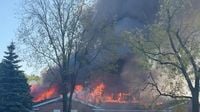In a devastating act of violence that has shaken the Michigan community and reverberated across the nation, a former U.S. Marine launched a deadly attack on the Church of Jesus Christ of Latter-day Saints in Grand Blanc Township, setting the building ablaze and leaving at least four dead and eight injured. Authorities fear the toll may yet rise as investigators sift through the charred remains of the church, which had been packed with hundreds of worshippers on Sunday, September 28, 2025.
The suspect, identified as 40-year-old Thomas Michael Sanford, was killed at the scene during a shootout with police, ending a rampage that lasted only minutes but left an indelible scar on the community. Sanford’s actions, authorities say, were not the result of a sudden outburst, but rather the culmination of a long-simmering animosity toward the Mormon faith—a hatred he had expressed openly just days before the attack.
According to the Detroit Free Press, Kris Johns, a 44-year-old candidate for the Burton City Council, encountered Sanford while canvassing neighborhoods on September 22. Johns described the initial meeting as surprisingly cordial. “He was extremely friendly,” Johns recalled, noting that the two men chatted for about 20 minutes. Sanford spoke candidly about his service as a U.S. Marine in Iraq from 2004 to 2008 and the struggles he faced with drug addiction upon returning home. But the conversation, as Johns recounted, “took a very sharp turn” when Sanford began peppering him with questions about the tenets of the Mormon faith, the role of Jesus, the church’s history, and its founder Joseph Smith.
Johns, who has since been in contact with both Michigan State Police and the FBI, told the Detroit Free Press that Sanford’s animosity toward the LDS church was evident, but not initially alarming. “It was very much standard anti-LDS talking points that you would find on YouTube, TikTok, Facebook,” Johns said. Still, something about Sanford stuck with him. “There’s certain things you don’t forget,” he said. “This is not a forgettable guy.”
Sanford’s hostility, however, escalated quickly. As reported by iHeartRadio’s Jason Hall, Sanford went on a hateful tirade against Mormons, referring to them as “the antichrist” just days before the attack. This rhetoric, described as echoing common social media vitriol, now appears chillingly prescient in light of the events that unfolded on that fateful Sunday morning.
Witnesses and authorities described how Sanford drove his Chevrolet Silverado pickup truck directly into the front doors of the church, shattering the sanctuary’s calm. He then exited the vehicle, armed with an assault rifle, and began firing on parishioners as they gathered for worship. The chaos inside was unimaginable—hundreds of congregants scrambled for cover as bullets tore through the church. In the aftermath, bullet holes could be seen riddling nearby vehicles, a grim testament to the violence unleashed.
But Sanford’s rampage did not end with gunfire. He set the church on fire, using methods that authorities are still investigating. According to the New York Post, multiple improvised explosives were found on the property, prompting the deployment of a bomb squad to ensure the site’s safety. The fire quickly consumed the building, sending a massive plume of black smoke into the sky and reducing the historic structure to little more than ashes. The destruction was so complete that, as of Monday, September 29, authorities could not rule out the possibility that more victims remained trapped inside.
First responders arrived at the scene with remarkable speed. A Department of Natural Resources officer and a local township police officer were on site within about 30 seconds of the initial 911 call, according to multiple reports. Their swift action helped prevent even greater loss of life, but the carnage had already been wrought. Sanford himself was killed in a shootout with police, ending the threat but leaving a community in mourning and disbelief.
The scale of the tragedy is still coming into focus. At least four people have been confirmed dead, with eight others injured—some critically. Hundreds of worshippers had been present inside the church at the time of the attack, and the full extent of the casualties may not be known until the investigation is complete. Aerial footage shared online captured the enormity of the disaster, showing the church engulfed in flames and smoke billowing for miles.
For many, the attack has raised troubling questions about the intersection of online hate, mental health, and the lingering wounds of war. Sanford’s background as a Marine veteran who served in Iraq has prompted both sympathy and concern, as friends and family members struggle to reconcile his military service with the violence he inflicted. His mother, in a Facebook post cited by iHeartRadio, confirmed his service from 2004 to 2008, but offered little insight into the demons he may have faced upon returning home.
Investigators are now piecing together Sanford’s motives and the chain of events that led to the attack. The discovery of improvised explosives on church grounds has added a new layer of complexity to the case, with bomb squad experts combing the scene for evidence. Authorities have confirmed that Sanford acted alone and that there is no ongoing threat to the community, but the shockwaves of his actions will be felt for a long time to come.
As the community of Grand Blanc Township mourns its losses, local leaders and residents alike are grappling with how to move forward. The Church of Jesus Christ of Latter-day Saints, now reduced to rubble, had served as a spiritual home for generations. Its destruction is not just a loss of property, but a blow to the sense of safety and unity that many had taken for granted.
For Kris Johns and others who crossed paths with Sanford in the days leading up to the attack, the tragedy is a stark reminder of how quickly hate can turn to violence. The warning signs, Johns now realizes, were there—but few could have predicted the scale of what was to come.
In the aftermath, the community’s resilience will be tested. But amid the grief and uncertainty, there is also a determination to honor the victims, support the survivors, and ensure that such a tragedy is never repeated. The investigation continues, but for those touched by the events in Grand Blanc Township, the scars will remain long after the smoke has cleared.




